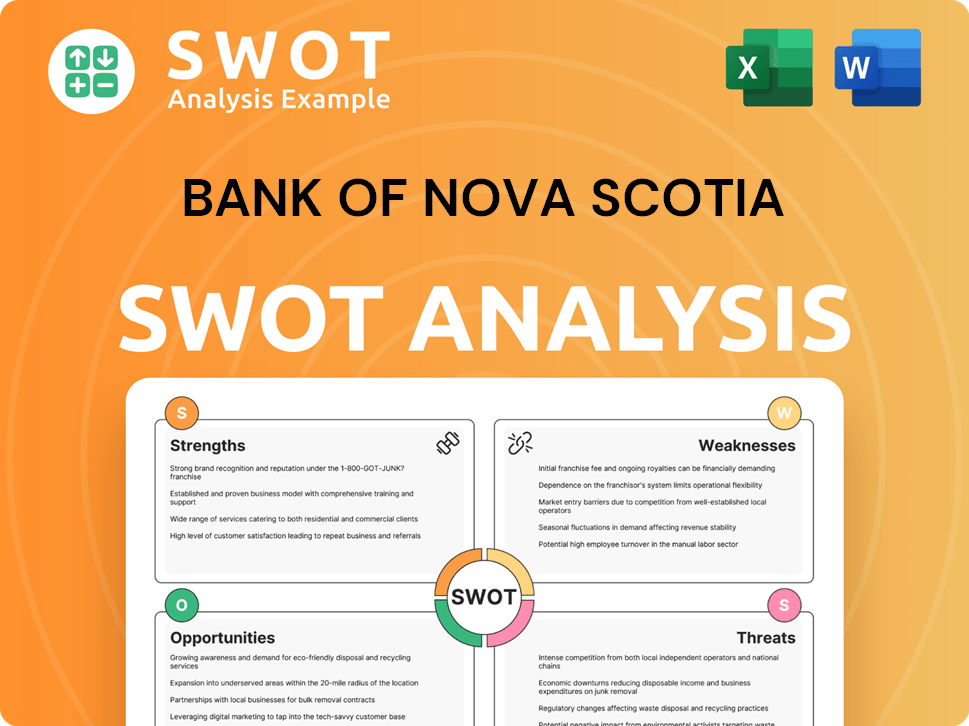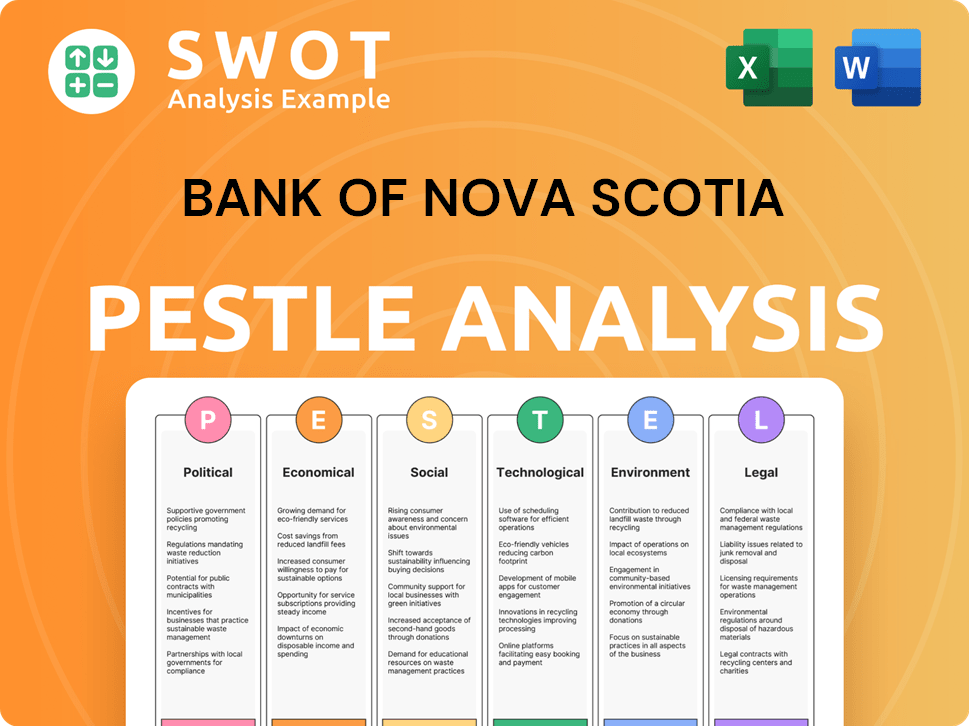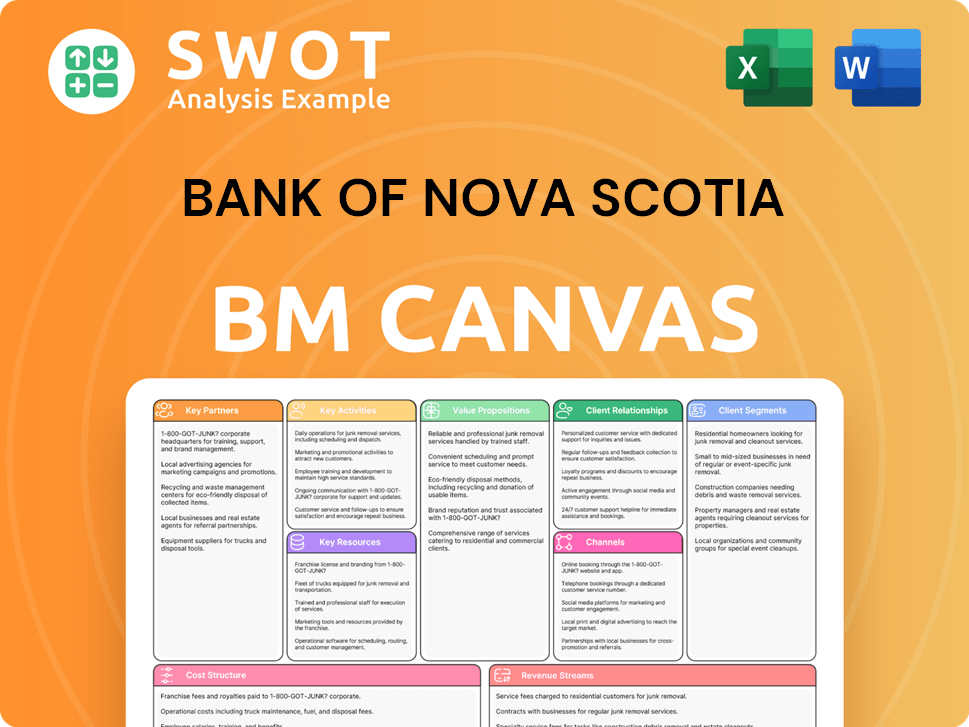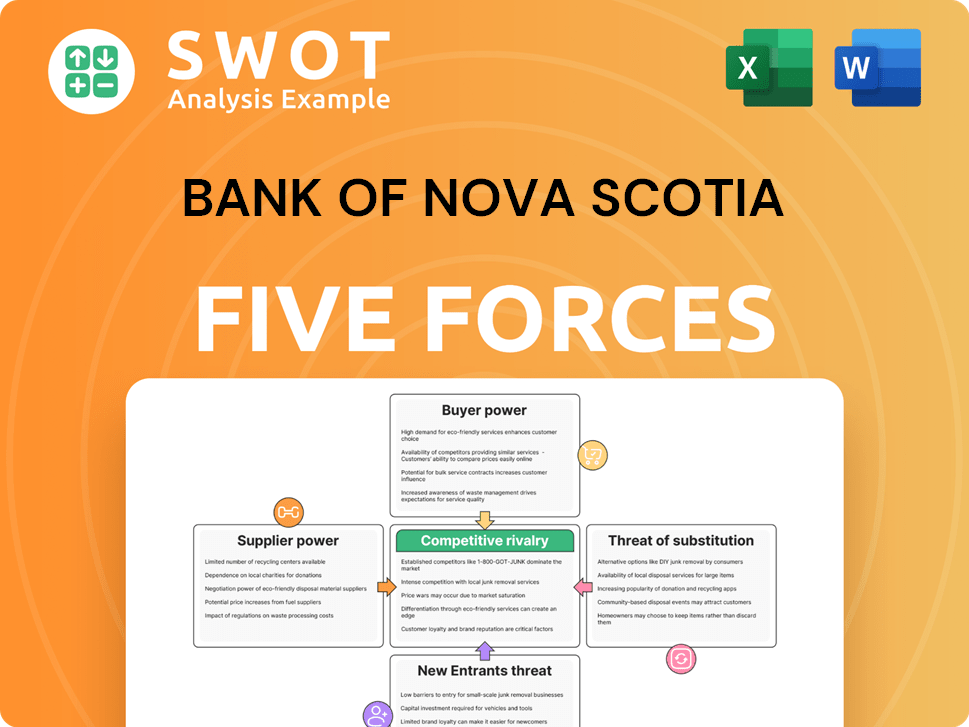Bank of Nova Scotia Bundle
How Did a Small Bank in Nova Scotia Become a Global Financial Powerhouse?
Embark on a journey through time to uncover the Bank of Nova Scotia SWOT Analysis, a financial institution with roots tracing back to 1832. From its inception in Halifax, Nova Scotia, this Canadian bank has weathered economic storms and embraced innovation. Discover the pivotal moments that shaped Scotiabank's remarkable transformation.

This brief history of Scotiabank explores its early years, from its founding to its expansion across Canada and beyond. Learn about the significant events in Scotiabank history, including its international growth and key milestones. Understanding the BNS history provides valuable insights into the evolution of banking and the strategies that have propelled Scotiabank to its current position as a leading financial institution.
What is the Bank of Nova Scotia Founding Story?
The Bank of Nova Scotia, now widely known as Scotiabank, has a rich history rooted in the early 19th century. Its founding was a direct response to the limited banking services available in Nova Scotia at the time. This brief history of Scotiabank traces its origins and early development.
The establishment of the Bank of Nova Scotia was a significant step in the evolution of Canadian banking. The bank's formation was driven by a need for accessible financial services for a broader range of businesses. This led to the creation of a financial institution that would play a crucial role in the economic development of Canada.
The Bank of Nova Scotia was formally incorporated on March 30, 1832, in Halifax, Nova Scotia. This followed a petition by 184 business owners and citizens. They sought a public bank to provide currency for trade transactions. The initial problem identified by the founders was the lack of accessible banking for the broader business community.
- The bank officially opened its doors on August 29, 1832, operating from the John Romans' building in Halifax.
- The Honourable William Lawson was elected as the Bank's first President, serving until 1837.
- The original staff included Cashier James Forman, Tellers Alexander Paul and Benjamin Carlile, and Messenger James Maxwell.
- The initial business model focused on trade financing, currency exchange, and providing credit to local businesses.
- The bank's charter was the first in Canada to include a provision for the double liability of shareholders.
- Initial funding involved an authorized capital of £100,000, with £50,000 required to be paid up before operations could commence.
- The Bank of Nova Scotia began issuing its own bank notes in denominations of Nova Scotia pounds. This was a common practice for Canadian chartered banks until 1945.
The early focus on trade financing and currency exchange was crucial for supporting the burgeoning trans-Atlantic trade. This strategic move helped the bank establish its foundation and contribute to the economic growth of Nova Scotia. To learn more about the financial workings of the bank, consider exploring the Revenue Streams & Business Model of Bank of Nova Scotia.
Bank of Nova Scotia SWOT Analysis
- Complete SWOT Breakdown
- Fully Customizable
- Editable in Excel & Word
- Professional Formatting
- Investor-Ready Format

What Drove the Early Growth of Bank of Nova Scotia?
The early growth and expansion of the Bank of Nova Scotia, or Scotiabank, was a pivotal period in its BNS history. Initially, growth was slow due to competitive pressures; however, the bank began to establish its presence within the Maritimes. This phase set the stage for its evolution into a significant Canadian bank.
Scotiabank's early history of Bank of Nova Scotia began with the opening of its first agency in Windsor, Nova Scotia, in 1837. This marked the commencement of its branch banking system. By 1874, the bank expanded beyond Nova Scotia, establishing a branch in Saint John, New Brunswick.
A key development was the amalgamation with the Union Bank of Prince Edward Island in 1883. This strategic move helped consolidate its position in the region. The bank's expansion then shifted westward within Canada.
In 1882, Scotiabank opened a branch in Winnipeg, Manitoba, and later expanded into the United States, with branches in Minneapolis (1885) and Chicago (1892). A significant milestone was the opening of a branch in Kingston, Jamaica, in 1889.
Recognizing the need for a national presence, the general head office was relocated from Halifax to Toronto in March 1900. The first dividend was paid on September 11, 1833, amounting to 3% of paid-up capital, marking a significant financial milestone.
Bank of Nova Scotia PESTLE Analysis
- Covers All 6 PESTLE Categories
- No Research Needed – Save Hours of Work
- Built by Experts, Trusted by Consultants
- Instant Download, Ready to Use
- 100% Editable, Fully Customizable

What are the key Milestones in Bank of Nova Scotia history?
The Bank of Nova Scotia, or Scotiabank, has a rich BNS history, marked by significant milestones and strategic shifts. Its journey reflects the evolution of a Canadian bank and its adaptation to global financial landscapes. Understanding the Scotiabank history provides insights into its current strategies and future prospects.
| Year | Milestone |
|---|---|
| 1975 | 'Scotiabank' was adopted as its worldwide brand name, marking a significant branding strategy. |
| 1986 | Scotia Securities was created to offer discount brokerage and security underwriting services, expanding its financial services. |
| 1988 | Acquisition of McLeod Young Weir, a leading Toronto brokerage firm, later renamed ScotiaMcLeod Inc., strengthened its market position. |
| 1995 | The wholesale arm of ScotiaMcLeod integrated with the bank's capital markets businesses to form Scotia Capital Markets. |
| 1995 | Acquisition of The Mocatta Group, a leading bullion dealer, forming ScotiaMocatta, expanded the bank's offerings. |
| 1999 | Corporate banking and capital markets businesses were integrated under the Scotia Capital banner. |
| 2012 | Scotia Capital rebranded as Global Banking and Markets to reflect its international reach. |
| 2023 | Scott Thomson became CEO in February, initiating strategic initiatives to improve market position. |
| 2024 | Sale of its Peru consumer finance business, part of a strategic portfolio optimization. |
| 2025 | Release of the 2024 Climate Report and 2024 Sustainability Report in March, highlighting sustainability efforts. |
Scotiabank has consistently innovated to meet evolving market demands. One key innovation was the establishment of Scotia Securities in 1986, followed by the integration of its wholesale arm with capital markets businesses to create Scotia Capital Markets. These moves reflect the bank's commitment to expanding its service offerings and adapting to the changing financial landscape. The Marketing Strategy of Bank of Nova Scotia has been a key factor in its growth.
The adoption of 'Scotiabank' as a global brand in 1975 was a pivotal move, unifying its international presence.
The creation of Scotia Securities in 1986 and the acquisition of McLeod Young Weir expanded service offerings.
Integrating the wholesale arm of ScotiaMcLeod with capital markets businesses to form Scotia Capital Markets streamlined operations.
The rebranding of Scotia Capital as Global Banking and Markets in 2012 signaled a broader international focus.
Acquiring The Mocatta Group in 1995 bolstered its position in the bullion market.
Ongoing investments in digital platforms and fintech partnerships to enhance customer experience and operational efficiency.
Scotiabank has faced several challenges throughout its banking history. These include market downturns, intense competition, and regulatory complexities, particularly in international markets. The bank has also had to navigate disruptions from fintech companies and evolving consumer preferences, necessitating strategic adjustments.
Economic downturns and fluctuating market conditions have consistently posed challenges to profitability and growth.
Intense competition within the Canadian bank sector and from international players impacts market share and margins.
Navigating complex and evolving regulatory environments both domestically and internationally adds to operational costs and risks.
The rise of fintech companies and digital banking platforms challenges traditional business models.
Political instability and economic uncertainties in international markets can impact operations and investment strategies.
Evolving customer preferences and the demand for digital services require continuous adaptation and investment.
Bank of Nova Scotia Business Model Canvas
- Complete 9-Block Business Model Canvas
- Effortlessly Communicate Your Business Strategy
- Investor-Ready BMC Format
- 100% Editable and Customizable
- Clear and Structured Layout

What is the Timeline of Key Events for Bank of Nova Scotia?
The Bank of Nova Scotia history is marked by significant milestones, from its inception in Halifax, Nova Scotia, to its current global presence. The evolution of Scotiabank, a prominent Canadian bank, showcases its adaptability and growth over nearly two centuries.
| Year | Key Event |
|---|---|
| 1832 | The Bank of Nova Scotia is founded in Halifax, Nova Scotia, and begins operations on August 29, marking the start of its banking history. |
| 1833 | The bank distributes its first dividend, a key indicator of its early financial success. |
| 1874 | Scotiabank expands beyond Nova Scotia, opening a branch in Saint John, New Brunswick. |
| 1883 | Scotiabank merges with the Union Bank of Prince Edward Island, broadening its reach. |
| 1889 | Scotiabank becomes the first Canadian bank to open a branch outside the U.S. or UK, establishing a presence in Kingston, Jamaica. |
| 1900 | The bank relocates its head office from Halifax to Toronto, reflecting its growing importance. |
| 1975 | The Bank of Nova Scotia officially adopts 'Scotiabank' as its worldwide brand name, simplifying its identity. |
| 1988 | Scotiabank acquires McLeod Young Weir, a leading Toronto brokerage firm, expanding its services. |
| 1999 | Corporate banking and capital markets businesses are integrated to form Scotia Capital, focusing on financial services. |
| 2012 | Scotia Capital is rebranded as Global Banking and Markets, streamlining its operations. |
| 2023 | Scott Thomson assumes leadership as President and CEO, guiding the bank's future. |
| 2024 | Scotiabank announces an agreement to acquire a 14.9% equity stake in KeyCorp, with the remaining 10% investment completed in December 2024, and full acquisition expected in fiscal 2025. |
| 2024 | Scotiabank reports net income of $7.89 billion for fiscal year 2024, a 6% increase from 2023. |
| 2025 | Scotiabank reports first-quarter net income of $993 million, which includes an impairment loss of $1,355 million related to the announced sale of banking operations in Colombia, Costa Rica, and Panama. |
| 2025 | Scotiabank releases its 2024 Climate Report and 2024 Sustainability Report, detailing its climate transition plan and sustainability initiatives. |
| 2025 | Scotiabank reports second-quarter net income of $2.03 billion, translating to $1.48 per share, and increases its quarterly dividend to $1.10 per share. |
Scotiabank's 'North America corridor' strategy focuses on redeploying capital into Canada, the U.S., and Mexico, with selective allocations to Chile and Peru, shaping the bank's future growth. This strategic focus is designed to capitalize on the economic potential within these regions, enhancing its market position.
The bank aims for earnings growth of 5% to 7% in 2025, with a target of double-digit growth in 2026. Net interest income is projected to increase from C$18,262 million in 2023 to C$22,449 million by 2026. These targets highlight the bank's financial ambitions.
Scotiabank is investing in digital banking platforms, artificial intelligence, and blockchain to streamline operations and improve security, reflecting its commitment to innovation and customer-centric services. These advancements are key to maintaining a competitive edge.
The bank is committed to social responsibility, including its goal to mobilize CAD 100 billion in sustainable finance by 2025 and its ScotiaRISE program. These initiatives demonstrate its dedication to environmental and social governance.
Bank of Nova Scotia Porter's Five Forces Analysis
- Covers All 5 Competitive Forces in Detail
- Structured for Consultants, Students, and Founders
- 100% Editable in Microsoft Word & Excel
- Instant Digital Download – Use Immediately
- Compatible with Mac & PC – Fully Unlocked

Related Blogs
- What is Competitive Landscape of Bank of Nova Scotia Company?
- What is Growth Strategy and Future Prospects of Bank of Nova Scotia Company?
- How Does Bank of Nova Scotia Company Work?
- What is Sales and Marketing Strategy of Bank of Nova Scotia Company?
- What is Brief History of Bank of Nova Scotia Company?
- Who Owns Bank of Nova Scotia Company?
- What is Customer Demographics and Target Market of Bank of Nova Scotia Company?
Disclaimer
All information, articles, and product details provided on this website are for general informational and educational purposes only. We do not claim any ownership over, nor do we intend to infringe upon, any trademarks, copyrights, logos, brand names, or other intellectual property mentioned or depicted on this site. Such intellectual property remains the property of its respective owners, and any references here are made solely for identification or informational purposes, without implying any affiliation, endorsement, or partnership.
We make no representations or warranties, express or implied, regarding the accuracy, completeness, or suitability of any content or products presented. Nothing on this website should be construed as legal, tax, investment, financial, medical, or other professional advice. In addition, no part of this site—including articles or product references—constitutes a solicitation, recommendation, endorsement, advertisement, or offer to buy or sell any securities, franchises, or other financial instruments, particularly in jurisdictions where such activity would be unlawful.
All content is of a general nature and may not address the specific circumstances of any individual or entity. It is not a substitute for professional advice or services. Any actions you take based on the information provided here are strictly at your own risk. You accept full responsibility for any decisions or outcomes arising from your use of this website and agree to release us from any liability in connection with your use of, or reliance upon, the content or products found herein.